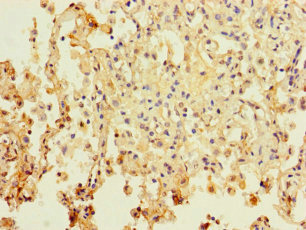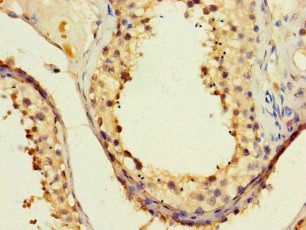
Immunohistochemistry of paraffin-embedded human lung cancer using CSB-PA761652LA01HU at dilution of 1:100
PAXIP1 Antibody
CSB-PA761652LA01HU
ApplicationsELISA, ImmunoHistoChemistry
Product group Antibodies
ReactivityHuman
TargetPAXIP1
Overview
- SupplierCusabio
- Product NamePAXIP1 Antibody
- Delivery Days Customer20
- ApplicationsELISA, ImmunoHistoChemistry
- CertificationResearch Use Only
- ClonalityPolyclonal
- ConjugateUnconjugated
- Gene ID22976
- Target namePAXIP1
- Target descriptionPAX interacting protein 1
- Target synonymsCAGF28, CAGF29, PACIP1, PAXIP1L, PTIP, TNRC2, PAX-interacting protein 1, PAX interacting (with transcription-activation domain) protein 1, PAX transcription activation domain interacting protein 1 like, protein encoded by CAG trinucleotide repeats
- HostRabbit
- IsotypeIgG
- Protein IDQ6ZW49
- Protein NamePAX-interacting protein 1
- Scientific DescriptionInvolved in DNA damage response and in transcriptional regulation through histone methyltransferase (HMT) complexes. Plays a role in early development. In DNA damage response is required for cell survival after ionizing radiation. In vitro shown to be involved in the homologous recombination mechanism for the repair of double-strand breaks (DSBs). Its localization to DNA damage foci requires RNF8 and UBE2N. Recruits TP53BP1 to DNA damage foci and, at least in particular repair processes, effective DNA damage response appears to require the association with TP53BP1 phosphorylated by ATM at Ser-25. Together with TP53BP1 regulates ATM association. Recruits PAGR1 to sites of DNA damage and the PAGR1:PAXIP1 complex is required for cell survival in response to DNA damage; the function is probbaly independent of MLL-containing histone methyltransferase (HMT) complexes. Promotes ubiquitination of PCNA following UV irradiation and may regulate recruitment of polymerase eta and RAD51 to chromatin after DNA damage. Proposed to be involved in transcriptional regulation by linking MLL-containing histone methyltransferase (HMT) complexes to gene promoters by interacting with promoter-bound transcription factors such as PAX2. Associates with gene promoters that are known to be regulated by KMT2D/MLL2. During immunoglobulin class switching in activated B-cells is involved in trimethylation of histone H3 at Lys-4 and in transcription initiation of downstream switch regions at the immunoglobulin heavy-chain (Igh) locus; this function appears to involve the recruitment of MLL-containing HMT complexes.
- ReactivityHuman
- Storage Instruction-20°C or -80°C
- UNSPSC41116161




